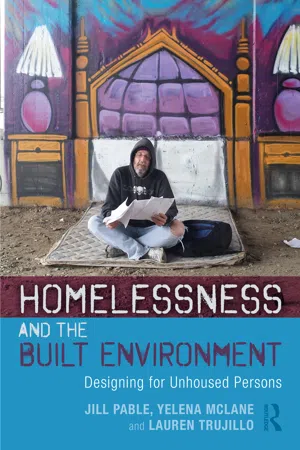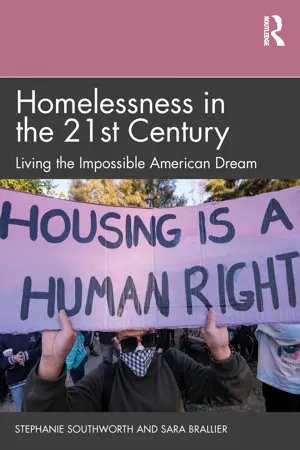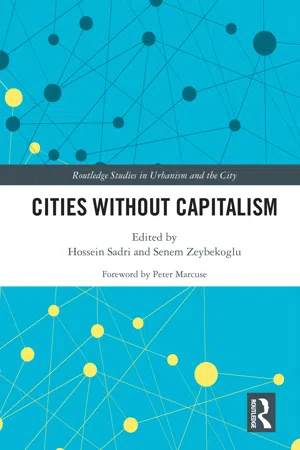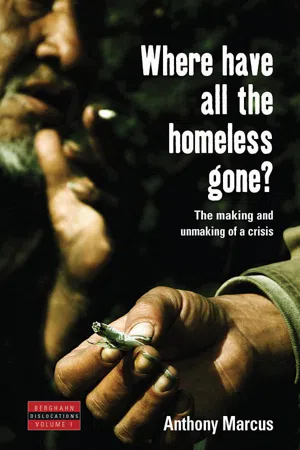History
Hoovervilles
Hoovervilles were makeshift communities of homeless people during the Great Depression in the 1930s. They were named after President Herbert Hoover and symbolized the widespread poverty and unemployment of the era. These shantytowns consisted of tents, shacks, and other improvised dwellings, and served as a visible reminder of the economic hardships faced by many Americans during that time.
Written by Perlego with AI-assistance
Related key terms
Related key terms
1 of 4
Related key terms
1 of 3
5 Key excerpts on "Hoovervilles"
- eBook - ePub
Homelessness and the Built Environment
Designing for Unhoused Persons
- Jill Pable, Yelena McLane, Lauren Trujillo(Authors)
- 2021(Publication Date)
- Routledge(Publisher)
At the turn of the century through the 1930s, most cities in the United States sought to address the vagrancy problem by constructing local poorhouses based upon institutional building models adapted from hospital and prison designs, or erecting clusters of unlocked huts referred to as “tramp dwellings.” In 1929, with the onset of the Great Depression, the need for such housing rapidly increased while the resources for new buildings and maintenance drastically diminished (Cresswell, 2001). By 1932, millions of Americans, hard-working men and women, had lost their homes and had to travel from place to place in search of employment. Some moved in with relatives, and, as unit densities soared, squatting became the norm. Others found shelter in one of the increasing numbers of buildings vacated after a business had closed, and families clustered in shantytowns near soup kitchens. Termed “Hoovervilles” (after Herbert Hoover, who was president of the United States when the Depression started and deemed culpable), at the height of the Depression, there were hundreds of these shelter camps across the country, with hundreds of thousands of people living in them. These settlements generally consisted of tents and shacks. Authorities did not officially recognize these Hoovervilles and occasionally removed the occupants for trespassing, but they were largely tolerated out of necessity. Under the social welfare programs of President Franklin Roosevelt’s New Deal, including the Federal Emergency Relief Administration (FERA) and the Works Progress Administration (WPA), unemployment and homelessness were alleviated through government-based jobs for skilled and unskilled laborers and assistance with reentering the rental housing market. President Roosevelt recognized that adequate housing was not only an individual need, but a societal need, and he declared the “right of every family to a decent home” in his 1944 State of the Union address (Roosevelt, 1944, para 69).2.5 Homeless man sitting in front of shack in shantytown known as Hooverville, Seattle, Washington, October 27, 1931.In Australia and New Zealand, the situation was very similar to that in the United States. The depressions of the 1890s and 1930s resulted in thousands of workers losing their jobs. Dilapidated infrastructure and overcrowded living conditions led to mass homelessness (Parliamentary Library Research Paper, 2014). Those who had to be “on the road” in search of work were mistrusted and treated with little sympathy (Waikato Times - eBook - ePub
Shantytown, USA
Forgotten Landscapes of the Working Poor
- Lisa Goff(Author)
- 2016(Publication Date)
- Harvard University Press(Publisher)
10In the early years of the Depression, shantytowns were often a better option than the other alternatives open to transients looking for work: municipal lodging houses, flophouses, or the mission. Many resented the mandatory attendance at religious services demanded by missions. A 1933 article in The New Republic recounted the municipal lodger’s experience: standing in long lines monitored by the police; reciting personal information to strangers; stripping for medical exams, showers and delousing; surrendering their clothes and personal possessions for fumigation; bad food; lights out at 6:00 p.m.; communal sleeping rooms that smelled of disinfectant and human odors. “Men were fed and housed in large numbers in one building without even the privacy of cattle kept in separate stalls.” These disadvantages recall the drawbacks of Freedmen’s Villages experienced by African Americans after the Civil War, with the federal government again filling the role of disingenuous shepherd, prodding transients on to the next town with promises of available jobs or more appropriate housing. Shantytowns, which offered privacy and conviviality, were often a cut above not only municipal lodging houses and missions, but hobo “jungles” on the edges of cities, where transient men (for the most part) bedded down in tents or shelters made of cardboard and bits of scrap lumber.11There were numerous Hoovervilles in New York City during the 1930s. Commissioned to paint murals of New York life on the ceiling of the rotunda in the U.S. Customs House in New York City, artist Reginald Marsh made sketches for a panel called Soup Kitchen [East River Shanties] . Now in the collection of the Museum of the City of New York, the watercolor sketch shows homeless African-American men gathered around a fire in a trash can, and a woman clutching a baby in front of a wooden shanty as her husband forages for materials nearby. Several other artists, including Louis Leon Ribak, Samuel Thal, and Charles Bayley Cook also painted Hoovervilles in the 1930s. One of the largest shantytowns in New York was Hoover City, located at Henry and Clinton streets in Brooklyn. By 1933, there were 600 people living in the 200 or so shanties in Hoover City, including a new baby. In addition to the usual scrap lumber, old pipes, and ash cans used to build shanties in previous decades, the Hoover City homes incorporated discarded truck bodies and floors made out of newfangled materials like linoleum. The moribund shipping industry also provided useful refuse: one resident made a bed out of two old metal sailors’ bunks.12 - eBook - ePub
Homelessness in the 21st Century
Living the Impossible American Dream
- Stephanie Southworth, Sara Brallier(Authors)
- 2023(Publication Date)
- Routledge(Publisher)
Legends of America. www.legendsofamerica.com/20th-Hoovervilles/ .- Heathcott, J. (2012). The strange career of public housing: Policy, planning, and the American metropolis in the twentieth century. Journal of the American Planning Association, 78(4), 360–375. https://doi.org/10.1080/01944363.2012.740296 .
- Ibid.
- Rossi, P. H. (1990). The old homeless and the new homelessness in historical perspective. The American Psychologist, 45(8), 954–959. https://doi.org/10.1037//0003-066x.45.8.954 .
- The high-rise public housing projects concentrated poverty in areas without resources, often in areas of cities that were near jobs. This concentration, along with the new suburbs, created an unprecedented level of racial and economic segregation in American cities.
- These benefits mostly went to White veterans. The impact of these benefits will be discussed in more detail in Chapter 2 .
- Rossi, P. H. (1990). The old homeless and the new homelessness in historical perspective. The American Psychologist, 45(8), 954–959.
Passage contains an image
Chapter 2 Neoliberal Ideology and Homelessness
DOI: 10.4324/9781003325581-3“I go here, I go there. No one understands that I can pay for housing. I just can’t pay that much. I need to be able to put gas in my car and eat.” Jared, a 40-year-old White maleIntroduction
Social problems, such as homelessness, do not occur in isolation and can be mitigated with good policy decisions. The magnitude of homelessness we see today was not inevitable. As we discussed in Chapter 1 , in the late 1970s, homelessness had almost disappeared from the social landscape in the United States. In his 1976 book about the history of housing, Anthony Jackson wrote, “The housing industry trades on the knowledge that no Western country can politically afford to have its citizens sleep in the streets.”1 - eBook - ePub
- Hossein Sadri, Senem Zeybekoglu, Hossein Sadri, Senem Zeybekoglu(Authors)
- 2021(Publication Date)
- Routledge(Publisher)
4 Tent city urbanism 1 Andrew HebenIntroduction
In February 2009, the American “tent city” suddenly took center stage following a special report on the Oprah Winfrey Show. Through the lens of a sprawling encampment along Sacramento’s American River, the report aimed to “humanize” the economic recession and housing foreclosure crisis occurring at the time. Tent cities were reported to be “makeshift shelters set up by people who have lost their homes and have nowhere to go.” Each person who appeared on screen gave a heart-wrenching story of recently losing his or her job to the recession, followed by losing his or her home to foreclosure. The conditions in Sacramento were said to be just one example in the “explosion of tent cities across America.”2Concurrently, Justin Sullivan of Getty Images released a photo essay documenting the very same camp.3 Existing conditions were juxtaposed with photographs of similar camps along the American River during the Great Depression – an unmistakable reference to the start of a Second Great Depression. These older camps of the 1930s were known as “Hoovervilles,” named after President Herbert Hoover, who was commonly thought to have been responsible for the desperate conditions that led to the development of the sprawling shantytowns in cities throughout the country.The photographs evoke sympathy by capturing the forlorn expressions of the victims with close-ups of the meager possessions that filled the camp. There is one, however, that stands out from the dismal tone set by the rest. Set in the depression days of 1936 Sacramento, it depicts a middle-aged man leaning back in his lawn chair with laundry hanging on a line in the background. He wears a wide smile as a small child and dog jump on to his lap while another young boy leans over the scene, also smiling. It reveals a rare glimpse into the lighter side of camp life, highlighting the resilience of humans to adapt when presented with challenges. Their possessions may be few but they will endure as a family. - eBook - ePub
Where Have All the Homeless Gone?
The Making and Unmaking of a Crisis
- Anthony Marcus(Author)
- 2005(Publication Date)
- Berghahn Books(Publisher)
The problem of defining adequate housing for the underhoused and adequate employment for the underemployed has been highly political throughout the twentieth century. In the popular imagination, there have been three major moments in the last hundred years of U.S. history in which the issue of people without housing has been important: the wanderings and dislocations of the great depression of the 1930s, the housing shortages in the wake of World War II, and the homeless crisis of the 1980s. All three of these crises occurred due to the inability of significant segments of the U.S. population to afford what was defined, at the time, as adequate housing. However, each was socially constructed in a different way, reflecting different historical circumstances and political forces, with different economic, social and political goals. A look at the way other crises of semipublic living were viewed gives some context to the formulation of homelessness as a national discourse in the 1980s.The Great DepressionMuch of the literature on underhoused populations in the 1930s originates with sociological literature on “tramps” and “hobos” that discusses housing loss and nomads in terms of psychocultural pathologies and sociocultural difference (Anderson 1923; Minehan 1934). Tramps and hobos were generally seen as social outlaws and lumped together with the poor and the underemployed into a world described in terms of faulty values and individual dysfunction. The recognition after October 1929 that the United States economy was crippled by a world economic crisis that would last for over a decade did not stop much of the academic, journalistic, and political discourse of the time from presenting this individualized vision of the deviant behavior of the poor (Sutherland & Locke 1936).The “bonus army” conflict of 1932 provides a dramatic example of the power of this traditional discourse on poverty. Largely without real housing to call their own, the World War I veterans and their families who camped out on the mall in Washington, D.C. demanded an early payment of the bonus that was supposed to be paid them in 1945 for military service rendered some fifteen years earlier. They were generally vilified in major newspapers and magazines and portrayed as a plague on the capital. When the U.S. army led by Douglas MacArthur, George Patton and Dwight Eisenhower drove the “bonus army” out of the streets killing civilians, destroying personal property, and injuring dozens, the official discourse on the incident portrayed the veterans as troublemaking vagrants and communist provocateurs who had no right to claim anything from their government. Few would have imagined that this group of people living in tents in front of the Capitol were people who had risked their lives in foreign service for their country. Red Cross records from the charity stations set up near the city of tents indicated that nearly all of the families present were veterans' families (Zinn 1995).
Index pages curate the most relevant extracts from our library of academic textbooks. They’ve been created using an in-house natural language model (NLM), each adding context and meaning to key research topics.
Explore more topic indexes
Explore more topic indexes
1 of 6
Explore more topic indexes
1 of 4




